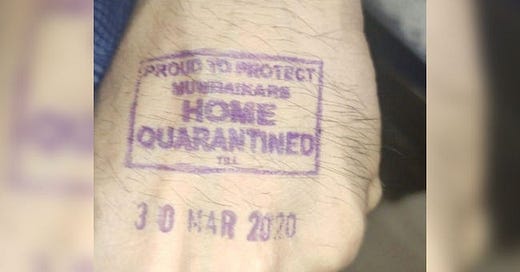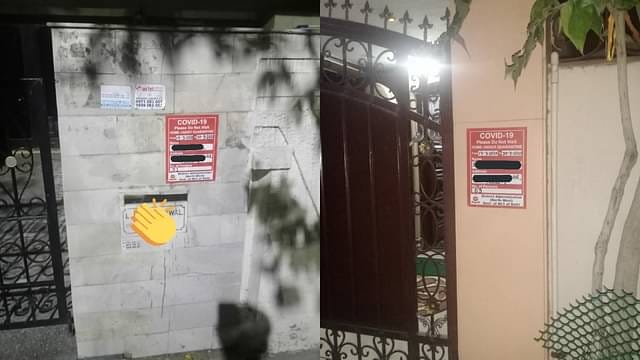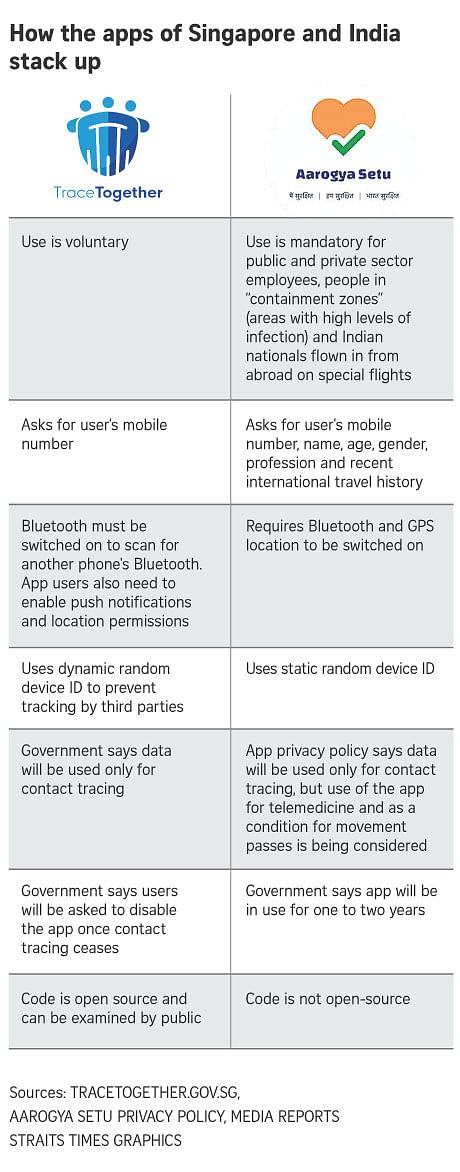COVID Lockdowns in India: part 1
The anatomy of the Indian Lockdown state, the Cinderella virus paradigm of pandemic management and a descent into the maelstrom of tyrannical madness.
Prelude to Madness
“What do you mean he’s afraid they’ll forcibly take him away?” I asked, dripping with incredulity. “He’s worried they’ll put him to one of the ‘COVID tents’ if he tests positive. It’s all over the news” explained my mother. The year was 2020, my brother had taken ill, and this was my mother’s response to my suggestion he get tested for COVID.
I was born in India (where my parents and brother still live) and moved to the US two decades ago. What follows is an account of the Indian response to COVID from a vantage point I consider unique—an Indian by birth, an American by assimilation, an infectious diseases physician by training and, perhaps most importantly, a human being watching agape in horror at the inexorable erosion of our civil rights at the hands of rapidly coalescing institutional power structures obliterating the notion of individual autonomy and do no harm and replacing it with noble harm in pursuit of the chimera of collective safety as the ultimate perverted expression of bureaucratic benevolence.
COVID-19 reached India around 30th Jan, 2020 and hit Maharashtra, my parental home state by early March. Within days, on 16th March, 2020, the same day as the now infamous US “15 days to slow the spread,” one Indian health commissioner took things to authoritarian Defcon level 1 by issuing orders forcibly quarantining anyone who disobeyed isolation mandates. On March 24, 2020, following the lead of the United States, the Indian government announced a three-week nationwide lockdown.
The Indian concept of time tends to be nebulous and somewhat abstract, and unlike western absoluteness, three weeks can imply any duration from 3 weeks to several months. So it shouldn’t surprise you then that these lockdowns extended beyond a year.
The anatomy of the Lockdown state and the Cinderella virus paradigm
Pre-Lockdown: 22nd March, 2020: The “Janta Curfew” (Translation: the people’s curfew): A 14 hour (7 a.m. to 9 p.m) crushing restriction that prohibited people from stepping out of their homes. Indian Prime Minister Modi deployed the National Cadet Corps and National Service Scheme to enforce a daytime curfew across the country. Penalties for violating the government diktat: up to a year in prison. Note the use of a 14 hour curfew. This became a recurring theme through the lockdowns. Did COVID magically mutate into a non-virulent strain at the the stroke of 9pm and transform back into a snarling son of Ebola at the break of dawn? What was the science behind what I would eventually christen the “Cinderella virus” paradigm pandemic response? Most people I spoke to simply shrugged their shoulders and said: “The people on TV say this prevents spread of the virus”
The Lockdown Period
Phase 1 (24 March – 14 April 2020): All services were suspended with the exception of “emergency” shops and hospitals. For the first time in the 167 years of its existence, the leviathan Indian Railway transport system was suspended and some trains were turned into isolation wards for COVID. Read that again. In a country with extreme poverty, with countless people living on the streets, people for whom public transport offers the only means of mobility, the pandemic response turned off their ability to get to safety, to their homes in some village far away, to flee to wherever they needed to go, while simultaneously terrifying them that their lives were in mortal danger and that being outdoors—to escape a disease spread exclusively indoors—was a certain death sentence.
Phase 2 (15 April – 3 May 2020): As expected, prime minister Modi extended lockdowns. However, as a paean to China inspired military pandemic management, he rolled out a “carrot and stick” approach which promised a much stricter Lockdown 2.0, but with the hope of gradual easing of restrictions for the obedient serfs while warning of even stricter measures for regions and jurisdictions that displayed noncompliance and insolence towards their authoritarian overlords
He said, "We have to ensure at all costs that coronavirus does not spread to a single new area. If any new patient is reported at local level, it will be a matter of concern for us." The primary enforcement arm of lockdown tyranny were the local police forces. Mr. Modi even said so explicitly "Severity of lockdown is being increased over next one week in the fight against coronavirus. Every town, every police station area, and every state will be examined on the basis of how strictly the lockdown is being followed there. It will be evaluated how much an area has prevented itself from coronavirus."
Phase 3 (4 May–17 May 2020): The lockdowns were extended for another 2 weeks, but with some relaxations. The country was split into 3 zones: red, orange and green based on case volume and doubling rates. Normal movement was permitted in green zones with public transport buses limited to 50 percent capacity. Orange zones would allow only private and hired vehicles but no public transportation while red zones remained under lockdown.
Phase 4 (18 May–31 May 2020): Two more weeks were added, but states were given a larger say in the demarcation of green, orange, and red zones.
The “Unlock” period: (1June to 30 November 2020): There were six “unlock” periods (Unlock 1.0 through 6.0) lasting one month each. These ostensibly allowed a gradual return to normalcy while leaving the door open for re-tightening restrictions if case numbers rose. They permitted restaurants, places of worship, hotels, etc. to reopen along with allowing some interstate travel. There remained significant restrictions on number of people that could gather at one place and all large gatherings were banned.
This wasn't a real unlock any sense of the word because:
Night curfews continued to be in effect during this period. Initially curfews were imposed from 9pm to 5 am and later from 10pm to 5 am. As mentioned earlier, there was this weird fairytale belief that much like Cinderella, the virus lost its fantastical superpowers after the clock struck a certain hour causing its virulent spike protein to transformed into a squishy pumpkin spike found on lowly cold viruses. What purpose did a midnight curfew serve at a time of day when the least number of people were present outdoors to diminish the spread of the disease that spread exclusively indoors?
All schools were closed (except partial reopening in a handful of states)
Lockdowns in 2021
(April 5–15 June 2021 ): A fresh wave of lockdowns were imposed in response to the “second wave” of COVID in India. And just as before, parks, shopping malls, places of worship, sit-in dining restaurants and schools were closed while evening curfews went into effect.
In case you’re still reading, lockdowns were well over a year in duration. And India boasted one of the world’s longest school closures in history with an average of 82 weeks or 574 days. It is estimated that only 24% of Indian households have access to internet at home.
Descent into the Maelstrom of Madness (Warning: disturbing content)
India’s pandemic mandates were imposed with a brutality, ruthlessness and utter disregard for human dignity that would’ve made the British colonial rulers of India’s past proud. The colonial era died a long time ago, but its legacy still lives and breathes through successive generations of India’s ruling elite who share their penchant for tyranny and subjugation.
There is no dearth of videos showing cops physically assaulting and humiliating Indian citizens who disobeyed lockdown mandates. The video below is just one example.

In one particularly brutal instance of mind-boggling depravity, two shopkeepers, P. Jeyaraj and his son J. Beniks were arrested in the Indian state of Tamil Nadu on 19 June 2020 for the crime of keeping their mobile accessories shop open beyond permissible hours during COVID lockdowns. They were sexually assaulted and tortured by the cops while in custody, eventually leading to their deaths.
In a stunning breach of patient privacy and privileged health information, the health department of the Indian state of Karnataka released the personal details of all patients quarantined for COVID in the state to the media, including their names mobile numbers and addresses exposing these individuals to threats of physical violence and intimidation.
Several Indian states physically displayed markings and stickers outside the homes of people under quarantine. Some even displayed the names of the patients.
The example above is from the country’s capital, New Delhi. The Delhi government explained the purpose as “cautioning others for their own safety”.
After pictures of this government issued scarlet letter surfaced online, the chief minister tweeted: “Delhi govt is marking all homes with persons advised to home quarantine. I appeal to all not to stigmatize such families. Please be empathetic and supportive towards them”


With empathy like this, who needs cruelty? If you aren’t disturbed enough, read the congratulatory replies to his tweet by his followers who thought this was a tremendous idea.
The Union territory of Chandigarh went full Sturmabteilung on their citizens: they not only labelled houses, but published a list of all infected and quarantined individuals to their administration’s website and put stamps on the right hands of suspected patients to reveal their quarantined time frame. One politician explained "There is apprehension that some people in home quarantine will not adhere to the guidelines. Any breach of this order will invite action under Section 188 of the Indian Penal Code"
One Indian administration officer called these measures “simple and sensible”
The most egregious violations of human rights are committed under the guise of compassion and greater good.


One journalist justified these violations of civil rights and privacy by claiming that “yellow flags” were used on ships during yellow fever and cholera and red crosses were drawn on doors during the bubonic plague outbreak of London citing two works of fiction: Gabriel Garcia Marquez’s ‘Love in The Time of Cholera’ and Daniel Defoe’s ‘A Journal of the Plague Year’ as evidence. Clearly, he too was following the science (of fiction)
Not to be outdone in the race to annihilate the remaining shards of their citizen’s dignity, my parental home state of Maharashtra decreed it a punishable criminal offense for any person evading compulsory quarantine or breaking 'home quarantine' and began forcibly moving them to government isolation facilities.
The picture below shows the not too uncommon practice of stamping the left hands of quarantined individuals with indelible ink that would last 14 days. Schutzstaffel would have been proud.
Which brings us full circle to where I started this article. What you see below is the actual door sticker put outside my family home. It warns neighbors to not associate with the COVID lepers and rattles off sections of criminal code infractions that would apply should the sick dare to break quarantine under pain of the law. The name and address of the local police station features prominently and neighbors are encouraged to call the cops should someone poke their heads out or, God forbid, leave the confines of their home prison.
The cherry on the icing of the dystopian cake was India’s contact tracing app, Aarogya Setu (Sanskrit: the bridge to health) which took a page out of the Chinese surveillance state playbook. The app was launched without a data protection law in India, and without a sunset clause on when health data collected would be deleted.
As demonstrated in the comparison table below, the app collected highly invasive personal details, tracked people relentlessly and was a goldmine for hackers. And of course the source code was secret. What could possibly go wrong?
An Entire City was forced to download the controversial contact tracing app —or go to prison. A senior police officer from the Noida police department told Indian media that the cops would conduct random checks on roads and at state borders to ensure that people have the app installed. Those caught without the app could face a fine of 1,000 rupees (around $13) or up to six months in prison (More than half of India’s 1.3 billion citizens do not have smartphones)
While Aarogya Setu’s stated purpose was contact tracing it predictably expanded to integrate e-pass functionality, a digital pass issuance system for inter and intra state travel; information bulletins, telemedicine consultations, and a self-assessment tool, which provides a COVID risk score that’s computed based on the personal data the app collected. The app was made mandatory for railway travelers.
Call it what you will, but in actuality the app was a sophisticated surveillance system that realized every despots wet dream of complete and utter control over their citizenry, required no congressional approval and faced no legal roadblocks to implementation. Because you know, declaring an emergency means carte blanche and never having to say you’re sorry.
It is my sincere (and maybe naïve) hope that the lessons learned from the excesses of the past—in the US and abroad— will serve as a cautionary reminder of the slippery slope of consequences that whiz past at break neck speed once a small group of individuals gain God-mode override control of the state machine and plunge it into the inky deep abyss of the kind totalitarian lunacy history books warn us about. The difference between the US and India in terms of their authoritarian excesses wasn’t in the will to encroach and subvert civil rights—there was plenty of that—but in the ability of US constitutional safeguards to kick in at the last minute (and barely so) whereas India still suffers the lingering ghost of its colonial past and her people have grown accustomed to being beaten into submission and ruled by iron hands, be it those of foreigners or one of her own.
The events of the last three years across the world illustrate by searing example that we’re always less than a generation away from losing our liberties and freedoms. People afflicted with generational amnesia don’t long for a past they’ve never known and suffering of the present becomes as natural as breathing.













Sorry, bookmarked this but forgot to get back to it till now! Never knew things were that bad in India, even though saw reports early on of difficulties in forcing city workers to return to home villages and huge loss of income for these hard-working simple folk. What I find ironical is that I understand India sees China as a rival and would like to paint itself as superior despite the lack of similar economic growth and infrastructure development; therefore the irony is that when push came to shove, they decided to emulate their rival's very worst authoritarian traits.
Love your phrase, "Cinderella virus". Many places had the same notion; for e.g. restaurants would have to close at in the evenings. Thank you for your unrelentless truth-telling. I'm impressed that you identify with the truth over your ethnic identity. I think perhaps that makes you more Indian than many of the culprits you've described here, probably including the PM! That’s because I understand Indian spiritual culture places a high value on what they call Sathya.
fantastic!